 The Draken Harald Hårfagre (Dragon Harald Fairhair, named after the first King of Norway), an ocean-worthy Viking longship, set sail early this morning from Norway on a daring voyage that will retrace the steps of great explorers like Erik the Red and his son Leif Erikson, the first European to cross the Atlantic and set foot on the American continent.
The Draken Harald Hårfagre (Dragon Harald Fairhair, named after the first King of Norway), an ocean-worthy Viking longship, set sail early this morning from Norway on a daring voyage that will retrace the steps of great explorers like Erik the Red and his son Leif Erikson, the first European to cross the Atlantic and set foot on the American continent.
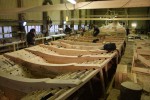 Sponsored by Norwegian businessman Sigurd Aase, construction on the vessel began in 2010 in Haugesund, Norway. It isn’t an exact replica of an extant Viking ship. While replicas of excavated ships have been made, they don’t work very well on the ocean because the originals were burial ships. They could be rowed, but they weren’t meant for the ocean voyages that took the Vikings across half the world. So instead of relying exclusively on archaeological remains, the builders of the Draken Harald Hårfagre combined traditional
Sponsored by Norwegian businessman Sigurd Aase, construction on the vessel began in 2010 in Haugesund, Norway. It isn’t an exact replica of an extant Viking ship. While replicas of excavated ships have been made, they don’t work very well on the ocean because the originals were burial ships. They could be rowed, but they weren’t meant for the ocean voyages that took the Vikings across half the world. So instead of relying exclusively on archaeological remains, the builders of the Draken Harald Hårfagre combined traditional  Norwegian boatbuilding knowledge, a living craft with deep roots going back to the Viking era, with archaeology — the 9th century Gokstad ship was one particular inspiration — and descriptions in the Norse sagas. It is an open clinker-built ship with an oak hull, Douglas fir mast, hemp rigging and a silk sail. At 115 feet long, 27 feet wide with 50 oars and a 3,200-square-foot sail, the Draken Harald Hårfagre is largest Viking ship built in modern times.
Norwegian boatbuilding knowledge, a living craft with deep roots going back to the Viking era, with archaeology — the 9th century Gokstad ship was one particular inspiration — and descriptions in the Norse sagas. It is an open clinker-built ship with an oak hull, Douglas fir mast, hemp rigging and a silk sail. At 115 feet long, 27 feet wide with 50 oars and a 3,200-square-foot sail, the Draken Harald Hårfagre is largest Viking ship built in modern times.
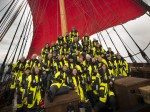 The aim from the beginning has been to create an operating Viking ship. That means roughing it in a serious way. There’s no under deck where the crew can rest and take shelter from the elements, just a large tent where 16 people at a time sleep in four hours shifts. The only space underneath the deck is a shallow space just large enough to carry ballast and food. The food is cooked is an open air kitchen on the deck, the ancestor of the galley discovered on the 15th century Dutch cog that was raised earlier this year.
The aim from the beginning has been to create an operating Viking ship. That means roughing it in a serious way. There’s no under deck where the crew can rest and take shelter from the elements, just a large tent where 16 people at a time sleep in four hours shifts. The only space underneath the deck is a shallow space just large enough to carry ballast and food. The food is cooked is an open air kitchen on the deck, the ancestor of the galley discovered on the 15th century Dutch cog that was raised earlier this year.
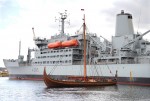 The ship was completed in 2012. The first sea trials were held in the fjords of Norway and after some adjustments were made, it set sail on its maiden overseas voyage in July of 2014 to Wallasey, in Merseyside, northwest England, which has a strong Viking history. The mast broke and the crew had to replace it in Wallasey, but they made it work. After three weeks of repairs, the ship sailed back to Norway via the Isle of Man, the Western Isles, Orkney and Shetland without a hitch.
The ship was completed in 2012. The first sea trials were held in the fjords of Norway and after some adjustments were made, it set sail on its maiden overseas voyage in July of 2014 to Wallasey, in Merseyside, northwest England, which has a strong Viking history. The mast broke and the crew had to replace it in Wallasey, but they made it work. After three weeks of repairs, the ship sailed back to Norway via the Isle of Man, the Western Isles, Orkney and Shetland without a hitch.
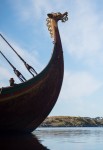 All of this was essential practice for the big show: the transatlantic voyage to North America. On April 23rd, the epic voyage was inaugurated with a Dragon’s Head Ceremony in which the dragon head so associated with Viking ships was mounted for the first time.
All of this was essential practice for the big show: the transatlantic voyage to North America. On April 23rd, the epic voyage was inaugurated with a Dragon’s Head Ceremony in which the dragon head so associated with Viking ships was mounted for the first time.
The dragon’s head is traditionally not mounted until departure for longer journeys and its purpose is to protect the ship and the crew from sea monsters, bad weather, evil creatures and unforeseen raids. The ships mythological head is uncovered in the ceremony, and the great adventure of sailing the historical route from Norway to Iceland, Greenland, Canada and the USA will be wished fair winds and following seas.
The ceremony was streamed live on YouTube to the delight of history nerds everywhere.
[youtube=https://youtu.be/GNhIwiTptYs&w=430]
The America Expedition is mind-bogglingly ambitious. Captain Björn Ahlander and a crew of 32 damn hardy men and women selected from 4,000 applicants have embarked on a voyage of 6,000 miles that will taken them to Iceland, Greenland, through the iceberg fields of the North Atlantic to Newfoundland, then to Quebec City, Toronto and into the US via the Great 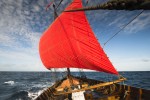 Lakes. The first US port of call will be Fairport, Ohio, and then on to Tall Ship festivals in Bay City, Michigan, Chicago, Illinois, Green Bay, Wisconsin and Duluth, Minnesota. Then it will head back east again through the Great Lakes, the canals of New York State to the Hudson River. Yes, a Viking longship will be going through canal locks. The sail is coming down for that part, obviously. After a stop in New York City in September, the Draken Harald Hårfagre will winter at the wonderful Mystic Seaport Museum in Mystic, Connecticut.
Lakes. The first US port of call will be Fairport, Ohio, and then on to Tall Ship festivals in Bay City, Michigan, Chicago, Illinois, Green Bay, Wisconsin and Duluth, Minnesota. Then it will head back east again through the Great Lakes, the canals of New York State to the Hudson River. Yes, a Viking longship will be going through canal locks. The sail is coming down for that part, obviously. After a stop in New York City in September, the Draken Harald Hårfagre will winter at the wonderful Mystic Seaport Museum in Mystic, Connecticut.
You can follow the voyage in real time on the expedition’s website and get updates from its Facebook page. If you’re interested in the construction and operation of the ship, check out its fascinating YouTube channel.

Fantastic voyage ! How nice to be able to re-live the experience.
With life vests and a ship accompanying them to ensure the crew can be rescued should catastrophe strike.
Oh, wow, I can’t wait to see this in person!
They’ll probably allow the public on to the ship in some places. :yes:
Duluth is located in Minnesota, not Wisconsin. Cheers!
Oh lawds, that was a bad one, espcially since the articles in the Duluth media were so thrilled over the trip because of Minnesota’s long history of Scandinavian communities. Fixed, thank you! :thanks:
“a ship accompanying them to ensure the crew can be rescued should catastrophe strike”: as long as they give priority to saving the ship first.
Woot! There are several places I will be able to see the ship! Can hardly wait– going to be following this online. I have some of that adventurous Viking blood.
“and in case they do survive,
the TV-broadcast will be live.”
“Es lebe der Sport” (70s Austrian pop song). Of course, I wish all the best. That song was mainly about downhill skiing, and in the original the lyrics refer to the post-race interviews.
Good luck to my modern Viking cousins! My DNA truly surprised me, so now this means even more! Fair Wind!
Thank goodness we now have a Coast Guard to turn back the raiding party when it disembarks. Although from the accounts in the Vinland sagas, it seems the indigenous peoples of North America did pretty well in that department a millennium ago.
You have your priorities right. Gods I’d like to be part of this
Fairport Harbor, OH is the official town name.